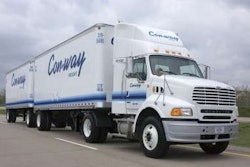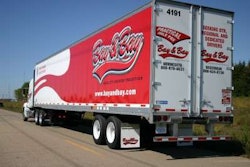New regime could benefit suppliers, lobbyist says
Although stronger Democratic majorities in Congress and a Democrat in the White House could mean trouble for heavy-duty vehicle suppliers in areas like labor and energy, the new regime might be receptive to suppliers in some areas, says Ann Wilson, vice president of government affairs for the Motor & Equipment Manufacturers Association. Wilson told attendees of the Heavy Duty Dialogue in Orlando, Fla., that she expects strong support for onboard safety technologies and environmental initiatives that might create greater commercial opportunities for suppliers.
“The election may help advance our issues, but the concern is mandates versus incentives,” Wilson told attendees. MEMA and its heavy-duty unit, the Heavy Duty Manufacturers Association, favor tax breaks and other incentives for the installation of safety technologies.
Wilson said she anticipated legislation being reintroduced soon to grant such incentives for vehicle stability systems, lane-departure warning systems, collision warning systems, brake sensors and other systems that the U.S. Department of Transportation determines to be worthwhile. The big problem with a mandate rather than incentives is that a mandate could take years to implement, Wilson said. Still, USDOT might be headed that way if Congress approves legislation to mandate certain technologies on motor coaches as it may do. USDOT has told Congress that if that legislation passes, it probably would extend mandates to all motor carriers, Wilson said.
One regulatory issue that MEMA is following closely is the ongoing National Highway Traffic Safety Administration rulemaking on stopping distance for highway tractors. Wilson pointed out that a rule supposedly was close when she joined MEMA five years ago, but it’s still not done. The big concern now is that all the research done to support the rulemaking dates back a number of years. “If they don’t finish it soon, our statistics and data might become outdated.”
But for some opportunities, the new regime brings some big threats, Wilson warned. A cap-and-trade system for carbon might not cover trucks, but it clearly would apply to suppliers’ manufacturing plants. And the so-called “card check” legislation is a big threat to any significant company that currently isn’t unionized, she said. She singled out HDMA-member companies with operations in Alaska, Alabama, Arkansas, Colorado, Indiana, Louisiana, Maine, North Carolina, Nebraska, Ohio and Pennsylvania that needed to contact their legislators to oppose the legislation, which would allow unions to organize without a secret ballot.
– Avery Vise
TCA names division winners of Fleet Safety Awards
The Truckload Carriers Association announced the 2008 division winners of its National Fleet Safety Awards, which recognize those companies that show a superior commitment to safety and accident reduction. The 18 companies were to be recognized at TCA’s annual convention March 10 in Orlando, as well as during TCA’s Safety & Security division annual meeting May 17-19 in Louisville, Ky.
The division winners now are eligible to compete for two grand prizes, one in the “under 25 million annual miles” category, and one in the “over 25 million annual miles” category. Below are the divisional winners based on low accident-frequency ratios per million miles:
· Division I winners (under 5 million miles): 1st Place, Rocha Transport, Modesto, Calif.; 2nd Place, Crown LSP Group Inc., Rocky Mount, N.C.; 3rd Place, Frerichs Freight Lines Inc., Belleville, Ill.
· Division II winners (5-14.99 million miles): 1st Place, Stone Belt Freight Lines Inc., Shoals, Ind.; 2nd Place, Glass Operating Group LLC, Newkirk, Okla.; 3rd Place, Landstar Gemini Inc., Jacksonville, Fla.
· Division III winners (15-24.99 million miles): 1st Place, Stagecoach Cartage & Distribution LP, El Paso, Texas; 2nd Place, Witte Brothers Exchange, Troy, Mo.; 3rd Place, CRST Dedicated Services Inc., Birmingham, Ala.
· Division IV winners (25-49.99 million miles): 1st Place, MacKinnon Transport Inc. Guelph, Ontario; 2nd Place, Freymiller Inc., Oklahoma City; 3rd Place, Kennesaw Transportation, White, Ga.
· Division V winners (50-99.99 million miles): 1st Place, Carter Express Inc., Anderson, Ind.; 2nd Place, Landstar Inway Inc., Jacksonville; 3rd Place, Navajo Express Inc., Denver
· Division VI winners (100+ million miles): 1st Place, Bison Transport Inc., Winnipeg, Manitoba; 2nd Place, Roehl Transport Inc., Marshfield, Wis.; 3rd Place, Hogan Transports Inc., Bridgeton, Mo.
2008 traffic deaths hit record low, NSC says
The National Safety Council announced that motor vehicle deaths in 2008 achieved the lowest rate since the NSC began publishing its annual Injury Facts statistical report in the 1920s. The estimated annual death rate from motor vehicle-related crashes in 2008 was 13 deaths per 100,000 people, a 9 percent decrease from 2007, according to NSC data. The estimated annual mileage death rate for 2008 was 1.38 deaths per 100 million vehicle miles traveled, a 4 percent decrease from 2007.
The estimated cost of crash-related deaths, injuries and property damage also decreased. The 2008 total, $237.2 billion, is 8 percent lower than the total cost in 2007.
NSC recorded 39,800 motor vehicle-related deaths in 2008, down 8 percent from 2007. NSC’s data-gathering method differs slightly from that of the U.S. National Highway Traffic Safety Administration. NSC researchers also clarified that while higher gas prices and other factors contributed to fewer miles driven in 2008 – and, thus, to the decrease in the number of people killed – the lower motor vehicle death rate demonstrates real reductions attributable to factors other than fewer miles driven, such as public education and visible enforcement of safety laws.
Preventable or not:Doe not in a sporting mood A few minutes before the accident, trucker John Doe had been listening, with rapt attention, to a CB recitation of how a devious doubles driver, Fred Farquark, had used a giant pepperoni and double-cheese pizza to bribe fleet mechanic Marv “Fats” Twiqley into significantly boosting his unit’s horsepower. Wow! Perhaps Fats didn’t want to keep his job? Then again, it was double cheese.
While pondering the immorality of the scenario, Doe extracted a Spicy Ranch Dorito from his survival rations and momentarily switched to “auto pilot,” neglecting to monitor his mirrors. It was 8 a.m. on a nice, sunny day as Doe, stifling a yawn, towed his trailer down four-lane Friendly Road in Greensboro, N.C. For the moment, Doe was riding in the inside lane.
A block ahead, a city bus began to pull into traffic from the right lane, trailing dense, acrid smoke. Doe, traveling at the posted limit of 35 mph, did not slow down. At that time, an impatient Mildred K. Morose, faced by the rear of the turtle-paced city bus, decided to try her favorite Grand Prix maneuver by attempting – alas, unsuccessfully – to race her yellow 1955 Porsche through the rapidly diminishing gap between the bus and Doe’s Class 8 tractor











